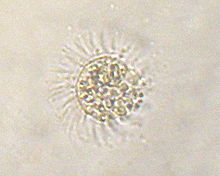Kleptoplasty
Kleptoplasty or kleptoplastidy is a process in
Etymology
The word kleptoplasty is derived from Ancient Greek κλέπτης (kléptēs), meaning 'thief', and πλαστός (plastós), originally meaning formed or moulded, and used in biology to mean a plastid.[1]
Process
Kleptoplasty is a process in symbiotic relationships whereby plastids, notably chloroplasts from algae, are sequestered by the host. The alga is eaten normally and partially digested, leaving the plastid intact. The plastids are maintained within the host, temporarily continuing photosynthesis and benefiting the host.[1] The term was coined in 1990 to describe chloroplast symbiosis.[2][3]
Taxonomic range
Kleptoplasty occurs in two major clades of eukaryotes, namely micro-organisms of the SAR supergroup, and some marine animals.
Eukaryota
|
| ||||||||||||||||||||||||||||||
SAR supergroup
Foraminifera
Some species of the foraminiferan genera Bulimina, Elphidium, Haynesina, Nonion, Nonionella, Nonionellina, Reophax, and Stainforthia sequester diatom chloroplasts.[4]
Alveolata
Dinoflagellates
The stability of transient plastids varies considerably across plastid-retaining species. In the
Ciliates

Karyoklepty is a related process in which the nucleus of the prey cell is kept by the host as well. This was first described in 2007 in M. rubrum.[8]
Animals
Rhabdocoel flatworms
Two species of rhabdocoel marine flatworms, Baicalellia solaris and Pogaina paranygulgus, make use of kleptoplasty. The group was previously classified as having algal endosymbionts, though it was already discovered that the endosymbionts did not contain nuclei.[9]
While consuming diatoms, B. solaris and P. paranygulus, in a process not yet discovered, extract plastids from their prey, incorporating them subepidermally, while separating and digesting the frustule and remainder of the diatom. In B. solaris the extracted plastids, or kleptoplasts, continue to exhibit functional photosynthesis for a short period of roughly 7 days. As the two groups are not sister taxa, and the trait is not shared among groups more closely related, there is evidence that kleptoplasty evolved independently within the two taxa.[10]
Sea slugs (gastropods)
Sacoglossa

Due to this unusual ability, the sacoglossans are sometimes referred to as "solar-powered sea slugs," though the actual benefit from photosynthesis on the survival of some of the species that have been analyzed seems to be marginal at best.[15] In fact, some species may even die in the presence of the carbon dioxide-fixing kleptoplasts as a result of elevated levels of reactive oxygen species.[16]
Changes in temperature have been shown to negatively affect kleptoplastic abilities in sacoglossans. Rates of photosynthetic efficiency as well as kleptoplast abundance have been shown to decrease in correlation to a decrease in temperature. The patterns and rate of these changes, however, varies between different species of sea slug.[17]
Nudibranchia
Some species of another group of sea slugs, nudibranchs such as Pteraeolidia ianthina, sequester whole living symbiotic zooxanthellae within their digestive diverticula, and thus are similarly "solar-powered".[18]
See also
References
- ^ PMID 18518896.
- ^ S2CID 9671982. Retrieved 2008-11-24.
- S2CID 87182226.
- .
- PMID 17227410.
- S2CID 4410812.
- PMID 20305031.
- S2CID 4410812. Retrieved 4 February 2015.
- ^ E. Marcus, Turbellaria Brasileiros (9). Bol. Fac. Fil. Ci. Letras Univ. São Paulo 16, 5–215 (1951).
- PMID 31328166.
- PMID 19951407.
- ^ Catherine Brahic (24 November 2008). "Solar-powered sea slug harnesses stolen plant genes". New Scientist. Retrieved 24 November 2008.
- ^ "SymBio: Introduction-Kleptoplasty". University of Maine. Archived from the original on 2008-12-02. Retrieved 2008-11-24.
- PMID 24767983.
- ISSN 2083-9480.
- PMID 25652835.
- PMID 29760759.
- ^ Sutton & Hoegh-Guldberg, Host-Zooxanthella Interactions in Four Temperate Marine Symbioses; Assessment of Effect of Host Extract on Symbionts; The Biological bulletin, Marine Biological Laboratory (Woods Hole, Mass.). v. 178 (1990) p. 175
External links
- "Solar Powered Sea Slugs". ABC Science Online. June 2007. Retrieved 2008-11-24.
